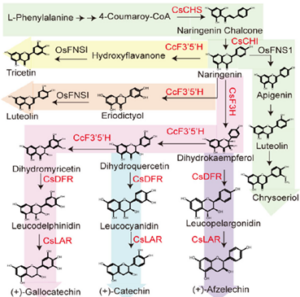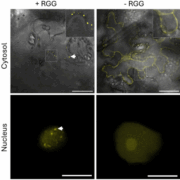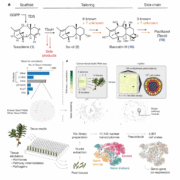“Tea rice”- the catechin fortified rice
 Rice feeds nearly half of the world population. Rice grains are rich in starch but low in micronutrients and bioactive compounds such as flavonoids. By contrast, tea leaves are rich in antioxidants such as catechins but low in calories. Zhu and colleagues combine the advantages of rice and tea by producing “tea rice”. They transformed six catechin synthesis genes from tea plant (Camellia sinensis) and montbretia (Crocosmia × crocosmiiflora) into rice plants and drove their expressions in the endosperm. The transgenic rice grains had increased catechins as well as other flavonoids including kaempferol and quercetin. Consistently, the transgenic rice grains also had increased antioxidating and radical-scavenging capacities. The antioxidating environment subsequently favours the accumulation of B-vitamins in the rice grains. The study sets a successful example of genetic engineering for metabolic flux redirection and multiple health-beneficial compound accumulation in rice. (Summary by Yee-Shan Ku @YeeShanKu1) Plant Biotechnol. J. 10.1111/pbi.70060
Rice feeds nearly half of the world population. Rice grains are rich in starch but low in micronutrients and bioactive compounds such as flavonoids. By contrast, tea leaves are rich in antioxidants such as catechins but low in calories. Zhu and colleagues combine the advantages of rice and tea by producing “tea rice”. They transformed six catechin synthesis genes from tea plant (Camellia sinensis) and montbretia (Crocosmia × crocosmiiflora) into rice plants and drove their expressions in the endosperm. The transgenic rice grains had increased catechins as well as other flavonoids including kaempferol and quercetin. Consistently, the transgenic rice grains also had increased antioxidating and radical-scavenging capacities. The antioxidating environment subsequently favours the accumulation of B-vitamins in the rice grains. The study sets a successful example of genetic engineering for metabolic flux redirection and multiple health-beneficial compound accumulation in rice. (Summary by Yee-Shan Ku @YeeShanKu1) Plant Biotechnol. J. 10.1111/pbi.70060






